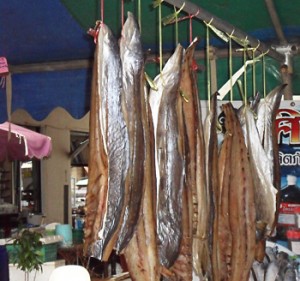Feast for the senses
September 19, 2009 by admin
Filed under Nakhon Si Thammarat, Related Interests
A riverside community in the South delights with its natural bounty
 There’s a host of things to see and do and lots of tasty tidbits to sample during a day’s outing to Pak Phanang, 36 kilometres east of Nakhon Si Thammarat town. During the 19th and early 20th centuries this district was the rice bowl of the far South. Its strategic location near the mouth (pak) of the Phanang River made it convenient for ships from British Malaya and even from as far away as Java to dock and load up with hulled rice from the steam-powered mills that lined a long stretch of the waterway. ”Commercial vessels no longer tie up along here,” said Paisarn Wipoosanapat, a local resident who’d volunteered to be our guide for the day, ”but we’ve preserved the old wooden shophouses and I think the atmosphere is similar to what it must have been like in the past.”
There’s a host of things to see and do and lots of tasty tidbits to sample during a day’s outing to Pak Phanang, 36 kilometres east of Nakhon Si Thammarat town. During the 19th and early 20th centuries this district was the rice bowl of the far South. Its strategic location near the mouth (pak) of the Phanang River made it convenient for ships from British Malaya and even from as far away as Java to dock and load up with hulled rice from the steam-powered mills that lined a long stretch of the waterway. ”Commercial vessels no longer tie up along here,” said Paisarn Wipoosanapat, a local resident who’d volunteered to be our guide for the day, ”but we’ve preserved the old wooden shophouses and I think the atmosphere is similar to what it must have been like in the past.”
King Chulalongkorn, who paid a visit in 1906, near the end of his reign, is on record as saying: ”I had been aware of the importance of this district, but … it far exceeded my expectations. I had not imagined it [to be] so big and so rich. The river is about as wide as the Chao Phraya at … Bangkok. It has fertile rice lands, even more so than those in the Rangsit canal area. And there is enough unused land to increase tenfold the area now under rice here. None of the ports on the eastern coast of the Malay Peninsula can hold a candle to Pak Phanang.” And we may well have been walking in that monarch’s footsteps as we wandered around the old market next to the river. ”This place has been going strong for more than a century,” Paisarn told us, ”and very little has changed in that time except for its size; it’s a lot smaller now than it used to be.” The reason for the downsizing, for this district’s rapid decline in commercial importance, is attributed to a decision made in 1955 by the government of Plaek Phibulsongkhram to set up a rice monopoly to buy surplus grain for export. The revenue this body raised was used to finance infrastructure projects for urban and industrial development.
 The price paid to the farmers, however, was 15 to 35 per cent below the going rate on overseas markets and this caused many landowners to convert their paddy fields to shrimp farms. So many, in fact, that a slew of rice mills were forced to close and saline run-offs from shrimp farms began polluting the local water supply. Earlier, Suthep Keasang, director of the Tourism Authority of Thailand’s Nakhon Si Thammarat office, had suggested we take a boat cruise along the river. ”And one thing you mustn’t miss while you’re at the market,” he said, ”is the dried fish. Pak Phanang is famous for its whole dried mullet and mullet roe.” And there was certainly plenty of it in evidence! Glad to escape the noisome fishy odours, we finally emerged onto the main street where stalls were selling local delicacies such as khao yam (rice served with a selection of raw vegetables and a sweet-and-salty sauce made from preserved fish) and khanom jeen, that national favourite of rice-flour noodles with veggies and a choice of spicy or slightly sweet nam ya curry. Farther along the street we came to a dilapidated-looking, three-storey building which, Paisarn informed us, was the first condo nok (”bird condominium”) in the district. It was built in the late 1920s and abandoned by its owners, a wealthy Thai-Chinese family, a few decades ago after it was discovered that swiftlets had begun nesting on the top floor. The temporary homes of these little creatures are, of course, the much-sought-after principal ingredient in bird’s nest soup, a medicinal product which fetches handsome prices, particularly in China. Today, according to figures kept by the TAT, no less than 250 structures have been erected in this district as artificial nesting sites for these feathered ”gold mines”. ”The interior of a condo nok is supposed to resemble a cave,” Paisarn explained. ”There’s no need for windows; just holes in the walls big enough to enable the birds to fly in and out.” The owners install water-sprinklers to keep the atmosphere sufficiently humid and play recordings of swiflet calls to attract more avian lodgers. ”If they fly into one of these buildings and like it, then they’ll stay and set up house. They want to live in comfort _ just like humans! The male helps the female build the nest, a task which usually takes around a month.” The locals we spoke to that day didn’t seem bothered about having to share their air space with thousands of noisy birds. ”I’m used to them. I’ve been living here since I was a boy,” said one 55-year- old. ”We’ve had no problems.”
The price paid to the farmers, however, was 15 to 35 per cent below the going rate on overseas markets and this caused many landowners to convert their paddy fields to shrimp farms. So many, in fact, that a slew of rice mills were forced to close and saline run-offs from shrimp farms began polluting the local water supply. Earlier, Suthep Keasang, director of the Tourism Authority of Thailand’s Nakhon Si Thammarat office, had suggested we take a boat cruise along the river. ”And one thing you mustn’t miss while you’re at the market,” he said, ”is the dried fish. Pak Phanang is famous for its whole dried mullet and mullet roe.” And there was certainly plenty of it in evidence! Glad to escape the noisome fishy odours, we finally emerged onto the main street where stalls were selling local delicacies such as khao yam (rice served with a selection of raw vegetables and a sweet-and-salty sauce made from preserved fish) and khanom jeen, that national favourite of rice-flour noodles with veggies and a choice of spicy or slightly sweet nam ya curry. Farther along the street we came to a dilapidated-looking, three-storey building which, Paisarn informed us, was the first condo nok (”bird condominium”) in the district. It was built in the late 1920s and abandoned by its owners, a wealthy Thai-Chinese family, a few decades ago after it was discovered that swiftlets had begun nesting on the top floor. The temporary homes of these little creatures are, of course, the much-sought-after principal ingredient in bird’s nest soup, a medicinal product which fetches handsome prices, particularly in China. Today, according to figures kept by the TAT, no less than 250 structures have been erected in this district as artificial nesting sites for these feathered ”gold mines”. ”The interior of a condo nok is supposed to resemble a cave,” Paisarn explained. ”There’s no need for windows; just holes in the walls big enough to enable the birds to fly in and out.” The owners install water-sprinklers to keep the atmosphere sufficiently humid and play recordings of swiflet calls to attract more avian lodgers. ”If they fly into one of these buildings and like it, then they’ll stay and set up house. They want to live in comfort _ just like humans! The male helps the female build the nest, a task which usually takes around a month.” The locals we spoke to that day didn’t seem bothered about having to share their air space with thousands of noisy birds. ”I’m used to them. I’ve been living here since I was a boy,” said one 55-year- old. ”We’ve had no problems.”
 A 15-minute drive from the market is the village of Ban Si Somboon where almost everybody seems to be expert in the production of a rice-based sweetmeat called khanom la, originally made as an offering for religion ceremonies. ”Every family here knows how to make it,” said Nongluk Chayarattanarak, who has converted her house into a small khanom la factory. She and her relatives churn out about 100 kilogrammes of the snack every day, distributing it to provinces across the South. We stood and watched as one very dextrous lady made a batch. First, she poured a mixture of fermented rice flour, palm sugar and honey into a metal container which resembled an empty tin can with a handle. Scores of holes had been bored into the bottom of this vessel which she then began swinging over a large wok, pre-heated and greased with coconut oil. Maintaining a rhythmic, circular motion, she had soon covered the base of the pan with a thin, golden-brown layer whose texture resembled a spider’s web.
A 15-minute drive from the market is the village of Ban Si Somboon where almost everybody seems to be expert in the production of a rice-based sweetmeat called khanom la, originally made as an offering for religion ceremonies. ”Every family here knows how to make it,” said Nongluk Chayarattanarak, who has converted her house into a small khanom la factory. She and her relatives churn out about 100 kilogrammes of the snack every day, distributing it to provinces across the South. We stood and watched as one very dextrous lady made a batch. First, she poured a mixture of fermented rice flour, palm sugar and honey into a metal container which resembled an empty tin can with a handle. Scores of holes had been bored into the bottom of this vessel which she then began swinging over a large wok, pre-heated and greased with coconut oil. Maintaining a rhythmic, circular motion, she had soon covered the base of the pan with a thin, golden-brown layer whose texture resembled a spider’s web.
 In a matter of seconds it had set hard and she was able to toss it onto a stack growing next to the wok. When cooled down, they are wrapped in plastic. Slightly sweet, they are wonderfully crisp if sampled which piping hot. Normally, the villagers sell them, wholesale, for 65 baht/kg. A kilogramme is probably enough to feed a small crowd, given that the diameter of one is equivalent to half the length of an adult’s arm! For ease of consumption khanom la are also formed into long tubes and then cut into short lengths. The last stop on our intinerary was the Pak Phanang River Basin Development Project which has brought great benefits to the people of Nakhon Si Thammarat and the neighbouring provinces of Phatthalung and Songkhla. It was initiated by HM the King to prevent saltwater intrusion into freshwater channels, retain reserves of water for year-round consumption, mitigate flooding and reduce conflicts over water between shrimp and rice farmers. During our tour of the project site we were taken to see a palace built by the locals to show their gratitude towards His Majesty. It took six years to finish and was handed over to the Royal Household Bureau in October, 2007. It consists of 13 buildings constructed in a simple but elegant southern style with materials like marble and teak. The roofs mimic the shape of a large flower in the hibiscus family called the dixie rosemallow.
In a matter of seconds it had set hard and she was able to toss it onto a stack growing next to the wok. When cooled down, they are wrapped in plastic. Slightly sweet, they are wonderfully crisp if sampled which piping hot. Normally, the villagers sell them, wholesale, for 65 baht/kg. A kilogramme is probably enough to feed a small crowd, given that the diameter of one is equivalent to half the length of an adult’s arm! For ease of consumption khanom la are also formed into long tubes and then cut into short lengths. The last stop on our intinerary was the Pak Phanang River Basin Development Project which has brought great benefits to the people of Nakhon Si Thammarat and the neighbouring provinces of Phatthalung and Songkhla. It was initiated by HM the King to prevent saltwater intrusion into freshwater channels, retain reserves of water for year-round consumption, mitigate flooding and reduce conflicts over water between shrimp and rice farmers. During our tour of the project site we were taken to see a palace built by the locals to show their gratitude towards His Majesty. It took six years to finish and was handed over to the Royal Household Bureau in October, 2007. It consists of 13 buildings constructed in a simple but elegant southern style with materials like marble and teak. The roofs mimic the shape of a large flower in the hibiscus family called the dixie rosemallow.
SOURCE :
Writer: KARNJANA KARNJANATAWE
Published: 17/09/2009 at 12:00 AM
Newspaper section: Horizons
Bangkok Post
















